- Like
- SHARE
- Digg
- Del
- Tumblr
- VKontakte
- Flattr
- Buffer
- Love This
- Save
- Odnoklassniki
- Meneame
- Blogger
- Amazon
- Yahoo Mail
- Gmail
- AOL
- Newsvine
- HackerNews
- Evernote
- MySpace
- Mail.ru
- Viadeo
- Line
- Comments
- Yummly
- SMS
- Viber
- Telegram
- JOIN
- Skype
- Facebook Messenger
- Kakao
- LiveJournal
- Yammer
- Edgar
- Fintel
- Mix
- Instapaper
- Copy Link
The Five Exercises You Should NEVER Do
 A Detailed Look at the Top 5 Worst Exercises that Can Cause Injury
A Detailed Look at the Top 5 Worst Exercises that Can Cause Injury
Physical activity is absolutely essential for overall health and wellness. However, all exercise is not created equal.
According to the American College of Sports Medicine (ACSM) guidelines, the average person should perform moderate intensity cardiovascular exercise three to five days per week in order to maintain health. Moderate intensity exercise is defined as any exercise that keeps your heart rate between 50% and 85% of your estimated maximum heart rate.
Everyone should also perform resistance training exercises two to three times per week in order to maintain muscle mass and bone density, increase strength, and combat fatigue.
Now that you know how often to exercise, what types of exercises should you be doing? More importantly, which exercises should you avoid at all costs?
For starters, all resistance exercises should focus on larger muscle groups. Compound exercises are much more efficient and effective than working smaller muscle groups one at a time. Especially as you age, it becomes increasingly important to strengthen your legs, core, chest, and back.
I have found an alarming number of exercises out there that are impractical, uncomfortable, and useless from a functional standpoint. These five exercises are some of the most dangerous.
Seated Leg Extension
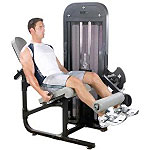 Top 5 Worst Exercises #1: Seated Leg Extension
Top 5 Worst Exercises #1: Seated Leg Extension
For the inexperienced exerciser, the seated leg extension seems like a simple and easily understood exercise. You simply load on the weight, lock yourself into a seated position, and use your quadriceps to lift the weight. However, from a biomechanical standpoint this exercise is one of the main culprits of aggravating existing knee issues, and even creating new ones.
Think of a seesaw, but imagine the two seats are different distances away from the center, one very close and one very far. On both seats there is a 200-pound man. In order for the man on the short arm to be able to lift the man on the long arm, he must exert almost impossible force on his end of the seesaw and the strain on the long arm of the seesaw would be extremely excessive, especially close to the axis.
In the above example, the axis represents the knee joint and the man represents the weight placed on the ankle. The tendons and ligaments in the knee are put under a massive amount of pressure, which is sure to aggravate any existing knee injury. Aside from being a functionally useless exercise, the body is not designed to life a weight in this way.
Tricep Dips
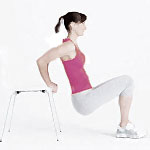 Top 5 Worst Exercises #2: Tricep Dips
Top 5 Worst Exercises #2: Tricep Dips
Tricep dips are an easy way to bulk up your arms at home or with little to no available equipment. However, the unnatural position of the shoulder in this exercise is bound to cause more harm than good.
The most vulnerable part of the shoulder in a tricep dip is the acromioclavicular (AC) joint. The AC joint is located on the top of the shoulder and is where the shoulder blade and collarbone meet. At the top of the dip when your elbows are locked out, there is enough stress on the AC joint to cause significant damage and even separation in an already weakened shoulder joint.
AC separations can range from mild instability to a complete tear of the ligaments binding the joint together. In addition, at the bottom of the dip all of the anterior shoulder ligaments and the anterior deltoid are under excessive stress that could also results in a tear. Countless people strive for sexy, defined triceps but there are much better and safer ways to get there than tricep dips.
Upright Row
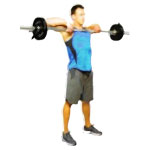 Top 5 Worst Exercises #3: Upright Row
Top 5 Worst Exercises #3: Upright Row
Although the shoulders and traps are popular muscles to workout and develop, especially for body builders, upright rows are quite simply the worst way to do this. You may be starting to notice a pattern: many taboo exercises affect the shoulder joint! The shoulder is a very complex and sensitive area. There are many small ligaments, tendons, and muscles involved with the functions of the shoulder and it is easy to stress these structures with unnatural movements in unnatural positions.
The upright row in particular causes the nerves in the shoulder area to compress. More specifically, the movement pattern for an upright row involved internal rotation of the shoulder. Internal rotation in itself is not a bad thing, but when you internally rotate your shoulder and then lift a weight there is a small tendon inside the shoulder that gets pinched each time you lift. This tendon, part of the supraspinatus muscle, is one of the most commonly injured parts of the shoulder.
To help you conceptualize internal rotation, hold your hands straight out in front of you with your palms facing the ground. Rotate your thumbs towards the floor and your pinkies towards the ceiling and notice the movement of the shoulder – this is internal rotation. A key point to keep in mind with any exercise is that nothing you do should take your body away from its biomechanical tendencies. If you a feel a strain while doing an exercise, it is probably because that exercise is unnatural from an anatomical standpoint, or you are doing it incorrectly. Listen to your body and if you feel pain beyond the normal effects of a workout, stop doing that exercise!
Behind the Head Lat Pulldown
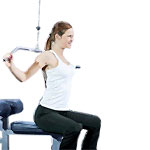 Top 5 Worst Exercises #4: Behind the Head Lat Pulldown
Top 5 Worst Exercises #4: Behind the Head Lat Pulldown
Exercisers who are a part of the “old school” of weight lifting were probably taught that a behind the head lat pulldown was the correct way to do a lat pulldown. Science is always advancing and exercises we once believed to be effective are now becoming obsolete. Make sure you stay up on the research and avoid injuries!
The problem with this variation of the lat pulldown is that only people with extremely flexible shoulder joints are able to do this exercise correctly. That’s right, we are back to the shoulder. We talked about how the upright row could hurt the shoulders because of internal rotation. This version of the lat pulldown forces the shoulders into external rotation.
Let’s use the same example to really see what this looks like. Hold your hands out in front of you again with your palms facing the ground. Now rotate your thumbs skyward until your palms are facing up – this is external rotation. In this position it is very difficult for the rotator cuff muscles to stabilize the shoulder joint and all of the small structures within the shoulder are very vulnerable to strains and tears. Since most people are not mobile enough to perform this exercise correctly, you will usually see exercisers pulling their head forward to get the bar behind their neck. This causes unnecessary strain on the back of the neck as well. As mentioned earlier, any exercise that strains the joints in an uncomfortable way should not be continued!
Good Mornings
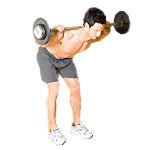 Top 5 Worst Exercises #5: Good Mornings
Top 5 Worst Exercises #5: Good Mornings
This exercise got its name because it resembles the old European custom of bowing slightly as a “good morning” greeting. The full exercise, however, is much more complete than a slight bow. The biggest danger of a good morning is the inability to drop the bar in case things go wrong. But there are some important biomechanical flaws with this exercise as well.
Good mornings are designed to work the majority of the posterior chain – hips, glutes, lower back, and hamstrings. Just as with the seated leg extension, this exercise can be compared to a lever; the load is way too far from the axis and leaves a lot of room for injury.
We can apply the seesaw example again except now the part of the body under maximum stress is the lower back. Improper form and excessive weight have caused countless exercisers to be out of commission for weeks and even months. This is one of those exercises that simply is not worth the risk. Back injuries are persistent, recurring, nagging, and never really seem to go away. Don’t compromise one of your most important anatomical structures for an exercise that works muscles that can easily be challenged in other, safer ways.
Final Thoughts
Armed with all of your new knowledge about these dangerous exercises, don’t let your trainer hurt you! If he or she prescribes an exercise or movement that doesn’t feel right or safe to you, STOP doing it! Pushing yourself to a limit that could cause injury isn’t worth it. If you get injured and have to take time off of working out, all of the gains you’ve made will start to disappear. Nobody wants that! Stop injuries before they happen and stay happy and healthy in your exercise routines for a long time to come.
About the Author: Jessica Rosen focuses on helping people achieve a healthy lifestyle for the long run by developing healthy habits in every aspect of life. She is currently a Thousand Oaks Personal Trainer.
See Also:
- What You Don’t Know About Exercise Can Hurt You
- Bodybuilding Injury Prevention
- Rotator Cuff Exercises to Prevent Injury
- Upper Body Stretches to Prevent Injury
- Best Lower Back Exercises to Prevent Injury
- Posture Problems and Injury Prevention
- Top Five Ways to Prevent Injury
- Top Five Weight Training Mistakes
- Entire Top Five Exercise Lists Collection
About Jessica Rosen
Author's Website I have always had an active lifestyle and played competitive sports since I was 8 years old. My dad is a chiropractor so I grew up always learning interesting things about joints, muscles, and bones. The human body is an incredible machine and it is capable of amazing things. I continued this passion for learning about the body at Cal Poly, San Luis Obispo where I studied Kinesiology with a concentration in Exercise Science and Health Promotion. I also minored in Psychology, which gives me a unique insight into the mentality behind fitness and weight loss as well. I worked as an EMT after college and got to see what happens when people do not take care of themselves and are resigned to their beds. I decided I wanted to make a difference in helping people to change their lives and get healthy before they reached the point of no return. I became a certified personal trainer through ACSM and have been able to make some incredible differences in the lives and health of my clients. I focus on helping people to achieve a healthy lifestyle for the long run by developing healthy habits in every aspect of life. My private sessions and boot camps are comprehensive and I believe it is never too late to make changes for the better!
